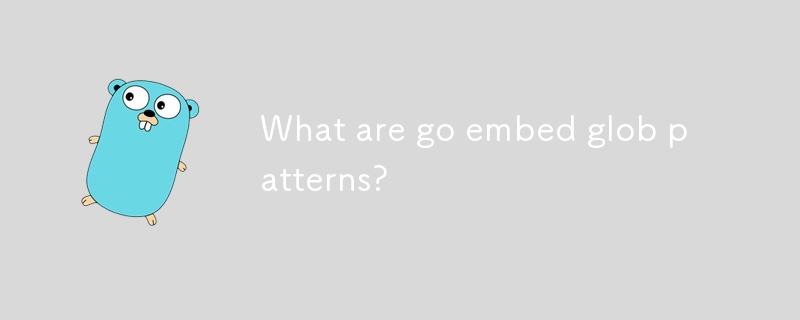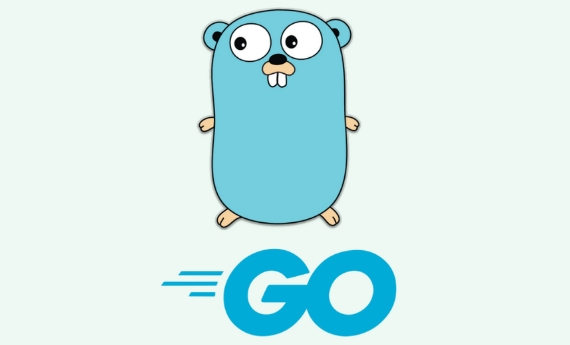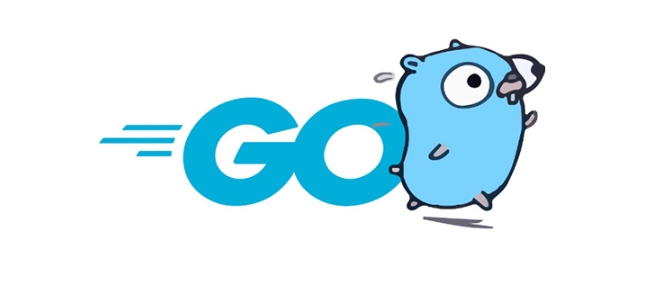Go's //go:embed directive supports using glob mode to embed files or directories at compile time. 1. Match non-delimited characters in single-level directories, such as .txt to match txt files in the same directory; 2. Match any hierarchical path, including cross-directory recursion, such as templates//.html can contain html files in all subdirectories; 3. Multiple files can be embedded by spaces, such as assets/.png assets/.jpg; 4. Brace expansion (such as .{png,jpg}) is not supported, and each pattern needs to be explicitly listed; 5. The path is relative to the source file directory, and supports embedded in string, []byte or embed.FS types, and hidden files will also be included if matches. All matches are determined at compile time, so you need to ensure that the file exists.

Go's //go:embed directive allows you to include files and directories directly in your Go binary at compile time. When using //go:embed , you can specify glob patterns to match multiple files or directories in a concise way. These are called embedded glob patterns .

What Are Glob Patterns?
Glob patterns are simple string patterns used to match file paths. They're not as powerful as regular expressions, but they're easier to write and widely used in file matching (like in shells or build tools).
In Go's embed context, glob patterns are used right after the //go:embed comment to tell the compiler which files to include.

Supported Glob Patterns in //go:embed
Go uses the path.Match function (from the path package) to evaluate glob patterns. Here are the key pattern features:
-
*— Matches any sequence of non-separator characters (ie, doesn't match/).- Example:
*.txtmatchesreadme.txtbut notdocs/readme.txt.
- Example:
-
?— Matches any single non-separator character. -
[abc]— Matches any one of the characters inside the brackets. -
**— Matches any sequence of characters including path separators (ie, it can cross directory boundaries).- This is not part of standard
path.Match, but Go'sembeddoes support ` ``** in a special way when needed for recursive matching.
- This is not part of standard
-
/— Literal path separator (use forward slashes even on Windows).
Common Use Cases and Examples
? Match all .txt files in a directory
//go:embed config/*.txt var configFiles embedded.FS
This includes config/app.txt , config/db.txt , but not config/subdir/info.txt .

? Match files recursively with **
//go:embed templates/**.html var templateFiles embedded.FS
This includes:
-
templates/home.html -
templates/users/index.html -
templates/admin/settings.html
The ** allows matching across subdirectories.
? Embed an entire directory tree
//go:embed static/* var staticFiles embedded.FS
Includes all direct children in static/ , but not nested files deeply if using single * .
To include everything recursively:
//go:embed static/** var staticFiles embedded.FS
? Match multiple file types
You can embed multiple patterns by separating them with spaces:
//go:embed docs/*.md assets/*.png config/*.json var content embedded.FS
You can also use comma-separated patterns inside curly braces (brace expansion), though that's handled by the shell or tooling — Go itself doesn't expand braces. So this won't work:
//go:embed assets/*.{png,jpg} // ? Not supported directlyInstead, list them separately:
//go:embed assets/*.png assets/*.jpg var images embedded.FS
Important Notes
- Paths are relative to the directory of the Go source file containing the
//go:embeddirective. - You can embed into:
-
stringor[]byte(for single files) -
embed.FS(for multiple files or directories)
-
-
**is supported only in the context of//go:embed— it's a special extension Go adds for recursive file inclusion. - Hidden files (like
.gitignore) are included if they match the pattern. - The glob matching is done at compile time , so it only sees files present then.
Summary
Go embedded glob patterns let you specify which files to include in your binary using simple pattern matching. Key patterns:
-
*→ matches within one directory level -
**→ matches recursively across directories (special support inembed) - Multiple patterns → separate by space
- No brace expansion → write full patterns
They're not full regex, but sufficient for most embedding needs — just keep paths clear and test with small examples.
Basically: use * for flat matches, ** for deep ones, and combine patterns as needed.
The above is the detailed content of What are go embed glob patterns?. For more information, please follow other related articles on the PHP Chinese website!

Hot AI Tools

Undress AI Tool
Undress images for free

Undresser.AI Undress
AI-powered app for creating realistic nude photos

AI Clothes Remover
Online AI tool for removing clothes from photos.

Clothoff.io
AI clothes remover

Video Face Swap
Swap faces in any video effortlessly with our completely free AI face swap tool!

Hot Article

Hot Tools

Notepad++7.3.1
Easy-to-use and free code editor

SublimeText3 Chinese version
Chinese version, very easy to use

Zend Studio 13.0.1
Powerful PHP integrated development environment

Dreamweaver CS6
Visual web development tools

SublimeText3 Mac version
God-level code editing software (SublimeText3)

Hot Topics
 Is golang frontend or backend
Jul 08, 2025 am 01:44 AM
Is golang frontend or backend
Jul 08, 2025 am 01:44 AM
Golang is mainly used for back-end development, but it can also play an indirect role in the front-end field. Its design goals focus on high-performance, concurrent processing and system-level programming, and are suitable for building back-end applications such as API servers, microservices, distributed systems, database operations and CLI tools. Although Golang is not the mainstream language for web front-end, it can be compiled into JavaScript through GopherJS, run on WebAssembly through TinyGo, or generate HTML pages with a template engine to participate in front-end development. However, modern front-end development still needs to rely on JavaScript/TypeScript and its ecosystem. Therefore, Golang is more suitable for the technology stack selection with high-performance backend as the core.
 How to build a GraphQL API in golang
Jul 08, 2025 am 01:03 AM
How to build a GraphQL API in golang
Jul 08, 2025 am 01:03 AM
To build a GraphQLAPI in Go, it is recommended to use the gqlgen library to improve development efficiency. 1. First select the appropriate library, such as gqlgen, which supports automatic code generation based on schema; 2. Then define GraphQLschema, describe the API structure and query portal, such as defining Post types and query methods; 3. Then initialize the project and generate basic code to implement business logic in resolver; 4. Finally, connect GraphQLhandler to HTTPserver and test the API through the built-in Playground. Notes include field naming specifications, error handling, performance optimization and security settings to ensure project maintenance
 How to install Go
Jul 09, 2025 am 02:37 AM
How to install Go
Jul 09, 2025 am 02:37 AM
The key to installing Go is to select the correct version, configure environment variables, and verify the installation. 1. Go to the official website to download the installation package of the corresponding system. Windows uses .msi files, macOS uses .pkg files, Linux uses .tar.gz files and unzip them to /usr/local directory; 2. Configure environment variables, edit ~/.bashrc or ~/.zshrc in Linux/macOS to add PATH and GOPATH, and Windows set PATH to Go in the system properties; 3. Use the government command to verify the installation, and run the test program hello.go to confirm that the compilation and execution are normal. PATH settings and loops throughout the process
 Go sync.WaitGroup example
Jul 09, 2025 am 01:48 AM
Go sync.WaitGroup example
Jul 09, 2025 am 01:48 AM
sync.WaitGroup is used to wait for a group of goroutines to complete the task. Its core is to work together through three methods: Add, Done, and Wait. 1.Add(n) Set the number of goroutines to wait; 2.Done() is called at the end of each goroutine, and the count is reduced by one; 3.Wait() blocks the main coroutine until all tasks are completed. When using it, please note: Add should be called outside the goroutine, avoid duplicate Wait, and be sure to ensure that Don is called. It is recommended to use it with defer. It is common in concurrent crawling of web pages, batch data processing and other scenarios, and can effectively control the concurrency process.
 Go embed package tutorial
Jul 09, 2025 am 02:46 AM
Go embed package tutorial
Jul 09, 2025 am 02:46 AM
Using Go's embed package can easily embed static resources into binary, suitable for web services to package HTML, CSS, pictures and other files. 1. Declare the embedded resource to add //go:embed comment before the variable, such as embedding a single file hello.txt; 2. It can be embedded in the entire directory such as static/*, and realize multi-file packaging through embed.FS; 3. It is recommended to switch the disk loading mode through buildtag or environment variables to improve efficiency; 4. Pay attention to path accuracy, file size limitations and read-only characteristics of embedded resources. Rational use of embed can simplify deployment and optimize project structure.
 Go for Audio/Video Processing
Jul 20, 2025 am 04:14 AM
Go for Audio/Video Processing
Jul 20, 2025 am 04:14 AM
The core of audio and video processing lies in understanding the basic process and optimization methods. 1. The basic process includes acquisition, encoding, transmission, decoding and playback, and each link has technical difficulties; 2. Common problems such as audio and video aberration, lag delay, sound noise, blurred picture, etc. can be solved through synchronous adjustment, coding optimization, noise reduction module, parameter adjustment, etc.; 3. It is recommended to use FFmpeg, OpenCV, WebRTC, GStreamer and other tools to achieve functions; 4. In terms of performance management, we should pay attention to hardware acceleration, reasonable setting of resolution frame rates, control concurrency and memory leakage problems. Mastering these key points will help improve development efficiency and user experience.
 How to build a web server in Go
Jul 15, 2025 am 03:05 AM
How to build a web server in Go
Jul 15, 2025 am 03:05 AM
It is not difficult to build a web server written in Go. The core lies in using the net/http package to implement basic services. 1. Use net/http to start the simplest server: register processing functions and listen to ports through a few lines of code; 2. Routing management: Use ServeMux to organize multiple interface paths for easy structured management; 3. Common practices: group routing by functional modules, and use third-party libraries to support complex matching; 4. Static file service: provide HTML, CSS and JS files through http.FileServer; 5. Performance and security: enable HTTPS, limit the size of the request body, and set timeout to improve security and performance. After mastering these key points, it will be easier to expand functionality.
 Go select with default case
Jul 14, 2025 am 02:54 AM
Go select with default case
Jul 14, 2025 am 02:54 AM
The purpose of select plus default is to allow select to perform default behavior when no other branches are ready to avoid program blocking. 1. When receiving data from the channel without blocking, if the channel is empty, it will directly enter the default branch; 2. In combination with time. After or ticker, try to send data regularly. If the channel is full, it will not block and skip; 3. Prevent deadlocks, avoid program stuck when uncertain whether the channel is closed; when using it, please note that the default branch will be executed immediately and cannot be abused, and default and case are mutually exclusive and will not be executed at the same time.






